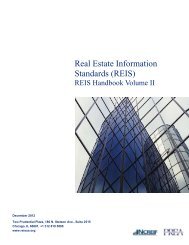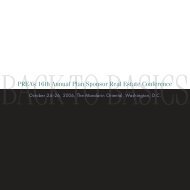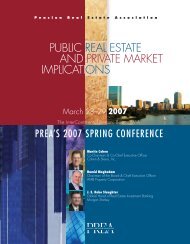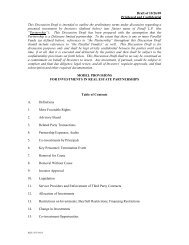Value Beyond Cost Savings - Green Building Finance Consortium
Value Beyond Cost Savings - Green Building Finance Consortium
Value Beyond Cost Savings - Green Building Finance Consortium
- No tags were found...
You also want an ePaper? Increase the reach of your titles
YUMPU automatically turns print PDFs into web optimized ePapers that Google loves.
Appendix GSustainable Property <strong>Cost</strong>-Benefit ChecklistPotential Property Benefits Description of Benefit Applicability Analysis 1065. More reliable functioning ofsystemsSustainable properties have the potential for more reliablefunctioning of systems due to the improved communicationamong participants in the development process due tointegrated design, commissioning, and recommissioning.The potential for more reliable functioning of systemsneeds to be offset by potential difficulties of systems ifthey are too pioneering in nature. Additionally, this is justone of many points that support improved buildingoperations, which is part of what will attract both spaceusers and investors. It is not necessary to preciselyquantify the incremental contribution of more reliablefunctioning of systems, just include it in the articulation ofpotential benefits if warranted by the subject property.F. Reduced Cash Flow/<strong>Building</strong> Ownership Risk1. Improve ability/cost to meetfuture regulatory compliance2. Ability to capitalize on futuregovernment incentives3. Improved ability to meetchanging space usersdemand4. Improved ability to meetchanging investor demand5. Prevent risk of loss of “sociallicense” to operate building6. Limit liability due to buildingrelated health issues—sickbldg, mold claims7. Limit exposure to futurecompelling health and/orproductivity research8. Reduced risk of reliance ongrid (terrorism)9. Increasedflexibility/adaptability10. Reduce risk of building notoperating as designed11. Limit exposure toSustainable properties are well positioned to significantlyreduce cash flow/building ownership risk. Lower risk willincrease value by lowering discount and capitalizationrates, and lower the required return necessary forinvestors/corporations to make a positive decision aboutsustainable property investment. (More detail in Chapter V:Section E: Assess <strong>Cost</strong>s/Benefits of Sustainability)For investors or lenders, the most important risk benefit isthe protection against future increases in demand forsustainable properties by regulators, space users, andinvestors. Given the dramatic increase in demand and thefact that lenders or investors will be evaluating cash flowstreams well into the future, protection against futurechange will be a critical risk benefit.Space users (tenants and corporate owner-occupants) willalso be interested in the risk benefits from regulatory andinvestor demand change, but will have even more directconcern about the ability to limit liability due to buildinghealth-related issues, limiting the risk of future energy orwater cost volatility, and other factors.The measurement and assessment of potential reducedcash flow/building ownership risk is based on acompilation of the underwriting of the subject property’sattractiveness to regulators, space users, and investors,as well as an assessment of reduced resource useprojections, and other factors.The traditional way discount and capitalization rates havebeen generated is through market research. Capitalizationrates are calculated based on evaluating comparablesales of commercial properties, and discount rates aretypically determined through an analysis of the most likelybuyer of a project, and their rates of return requirements,through surveys or other means. Market derived discountand capitalization rates are then adjusted for the specificconcerns and considerations of the particular property,given its risk attributes.When market transactions are limited, and capitalizationand discount rates are difficult to determine based onmarket evidence, or the number of property sales for aparticular specialized property type is too low (as is thecase with sustainable properties), the derivation ofcapitalization and discount rates relies more upon adetailed articulation and reconciliation of the riskincreasingand risk-decreasing factors of a particularproperty.270









